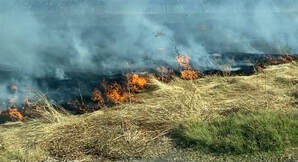Weed Abatement

The purpose of San Joaquin County Ordinance 4286, Title 4 Division 1. Chapter 6 is to compel the owner, lessee, or occupant(s) of buildings, grounds, or lots in the unincorporated portions of San Joaquin County to remove weeds and rubbish that constitute a public nuisance and fire hazard from such property and adjacent public right-of-ways, or pay the County the cost of removing the nuisance.
The following guide will assist you in complying with the requirements of the weed abatement program of San Joaquin County and make your property “Fire Safe.”
- FIRE HAZARD: (Defined for the purpose of weed abatement). Generally, any dry grasses, weeds, or rubbish that when exposed to an ignition source, could ignite and threaten or prove harmful to life, property, and or the environment.
- FIRE HAZARD REDUCTION: DRY GRASSES, WEEDS OR RUBBISH, WHICH HAVE BEEN DEEMED A FIRE HAZARD, SHALL BE ABATED AND KEPT ABATED THROUGHOUT THE FIRE SEASON. The time period designated as “THE FIRE SEASON” begins April 1st and ends October 30th, or any other time of the year that weather conditions may constitute unseasonably dry conditions.
- A DEFENDABLE SPACE shall be created around all structures, and other combustible properties and property lines, using one or more of the acceptable methods outlined below. Defendable Space is an area immediately adjacent to combustible properties, which has been cleared of combustibles, dry grasses and weeds, to create and maintain a minimum firebreak.
The recognized MINIMUM FIREBREAK is generally as follows:
Properties LESS than 2 acres: Properties MORE than 2 acres:
Pasture or Farm Land:
The entire property to be abated.
100 ft. firebreak around all structures and property lines. It is the option of the Fire District to abate the whole property when surrounding exposure warrants it. If you are in question, please contact your fire district.
15 ft. firebreak around property lines and 100 ft. around all structures and combustible exposures, (haystacks, barns, etc).
Property owners are required to provide large firebreaks on properties that have limited access, insufficient water supply and contain a high fire load.
Note: The San Joaquin County Board of Supervisors has also adopted an ordinance requiring the property owner to maintain the public right of way adjacent to their property free of fire hazards.
Acceptable methods of making firebreaks:
Discing or Rotor-tilling: (Preferred Method) Grasses and weeds may be disced or rotor-tilled to reduce
the hazard or to create a firebreak. Laying the weeds over with a drag device is not acceptable.
Cutting/Mowing: Grasses and weeds that have been cut or mowed must be REMOVED or
SPREAD so as not to present a fire hazard and the remaining vegetation growth shall be maintained at “NO HIGHER THAN 4 INCHES”.
PROPERTIES WITH LIVESTOCK: Grasses and weeds may be abated by the use of livestock. However, all other firebreaks and defendable space guidelines still apply. A 10 ft. firebreak around property lines is required, and it is still the option of the Fire District to abate weeds on properties where the amount of animals on the property could not maintain a reasonably safe fire condition.
